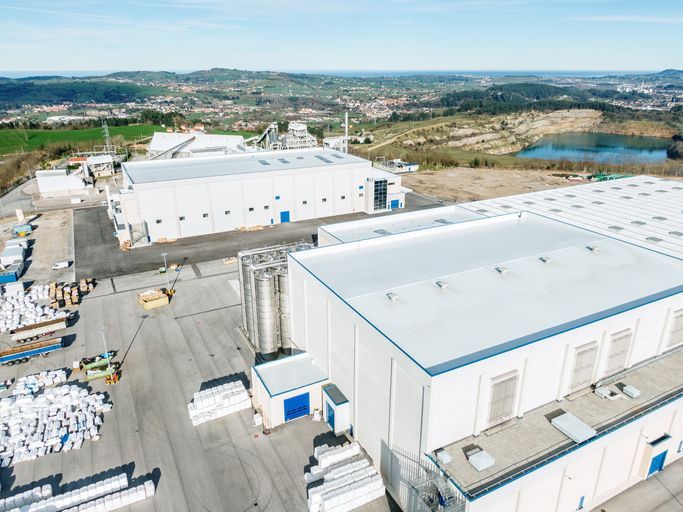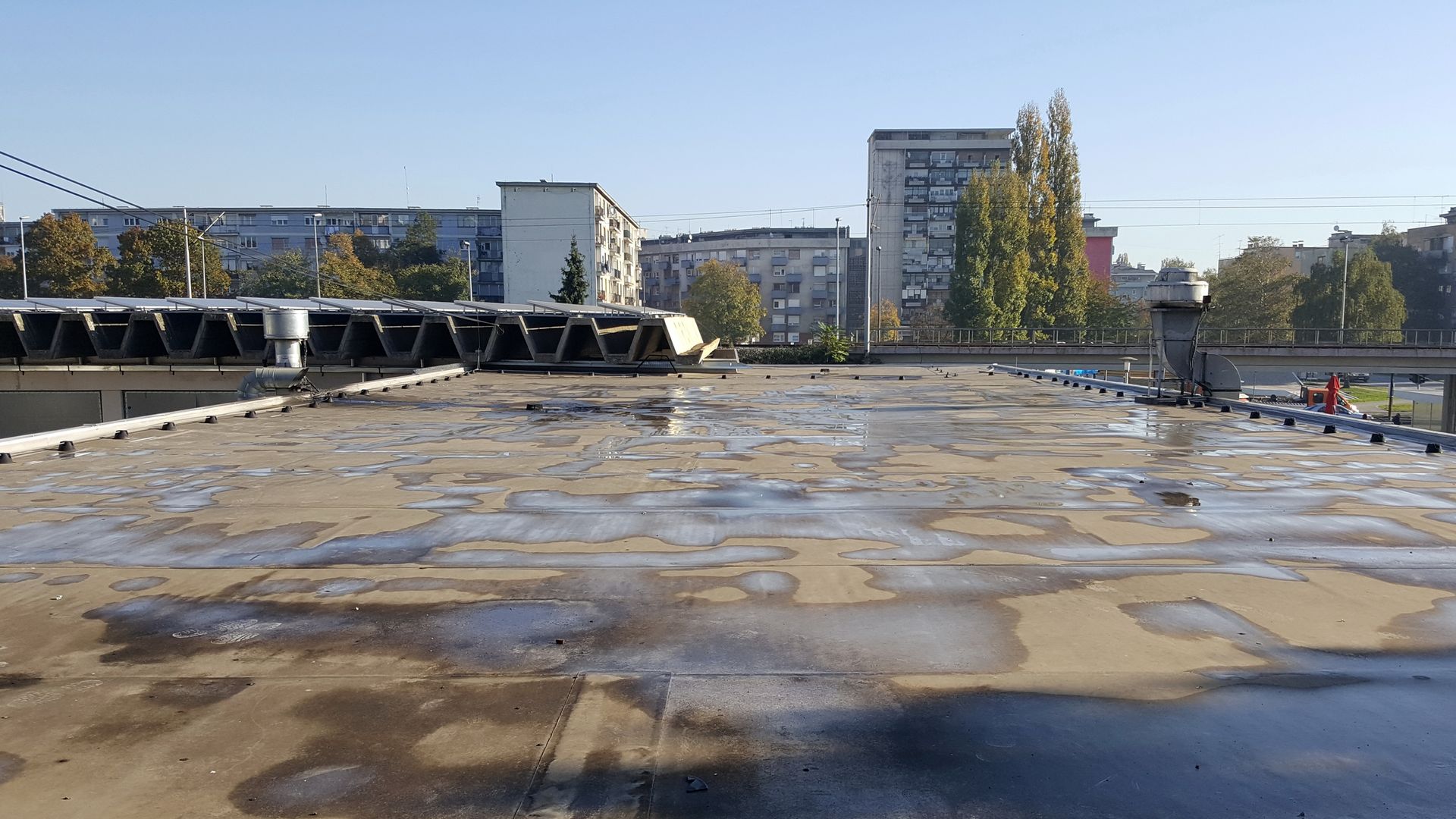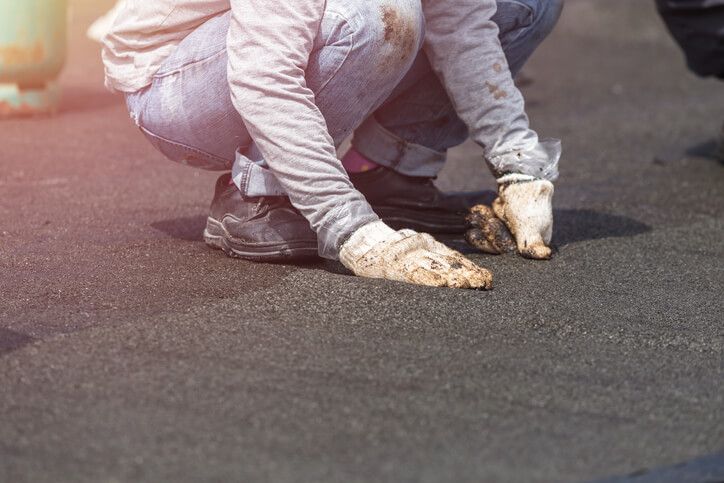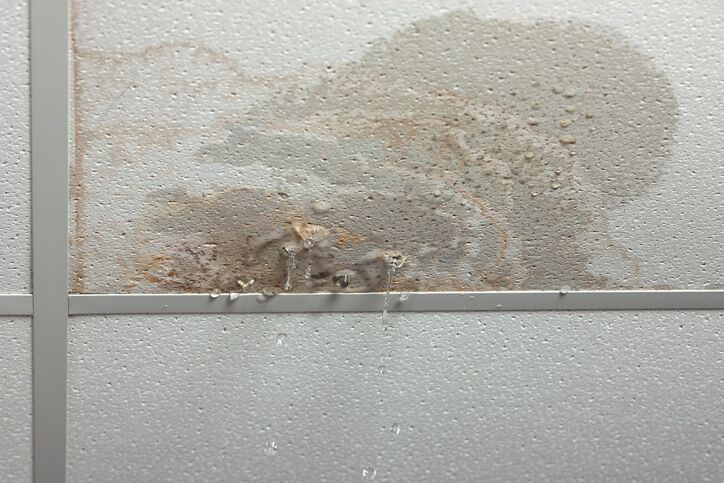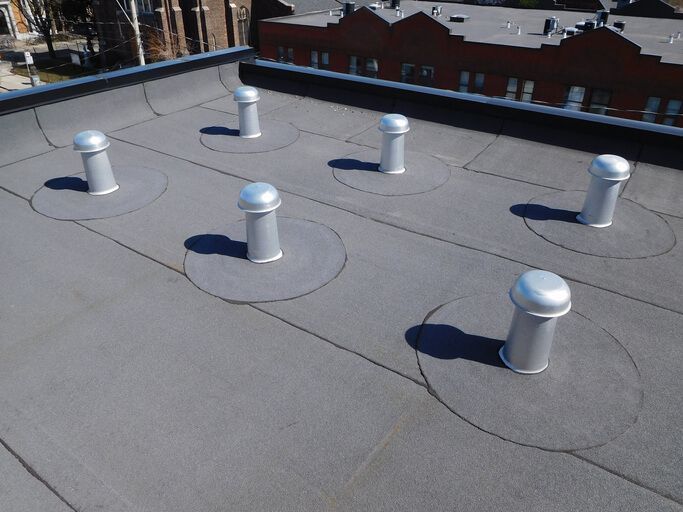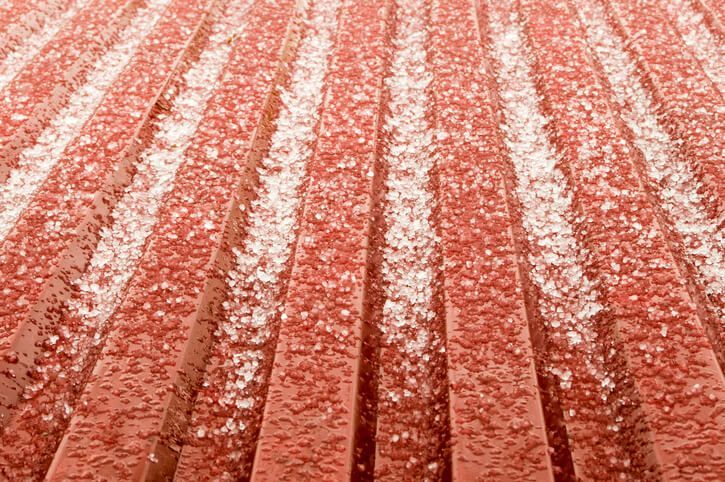Commercial Roofing Guide
The best way to make the right roofing decisions for your commercial property is to understand the types of roofing available, the lifespan of your roofing, and how you can prevent damage to your commercial roofing system.
What Material is My Commercial Roof?
There are a variety of materials that commercial roofs can be made of, including:
Built-Up Roofs
This type of roofing system is also referred to as a hot tar or hot asphalt roof, and in some cases, they are covered in gravel or left smooth. Without a gravel top later, this type of roofing is subject to UV degradation leading to the material becoming brittle and cracking.
With our Advantage Systems Roofing System, the material we use is seamless and highly reflective. Our modified asphalt mastic is reinforced with binders to prevent cracking.
Rolled Roofing
Rolled roofing, or 90-pound, is like shingles. This is a light-duty roof usually used as a temporary roof on sloped surfaces. On the other hand, our Advantage Systems Roofing System is suited for low sloped, flat, and sloped roofs, providing a longer lifespan and a lower lifecycle cost than a rolled roof system.
Metal Roofs
Metal roofing is most commonly made from steel or aluminum with a variety of corrugations. Metal roofs have a lot of laps and fasteners, which often results in leaking. It is also difficult to change a sloped roof to a metal one since a metal roof requires a different type of building design, which can lead to structural issues. With our seamless Advantage Systems Roofing System, there are no exposed fasteners or laps preventing leaking.
PVC/TPO
PVC (Polyvinyl Chloride)/TPO (Thermoplastic Polyolefin) roofs are composed of a thin layer of thermoplastic that is adhered or mechanically installed on the structure. Over time, these materials become brittle and are easily damaged by hail, punctures, and foot traffic.
Rubber Roofs
Rubber roofing is composed of a thin synthetic material known as EPDM. This material, due to its darker color, absorbs the heat rays of the sun, which can accelerate deterioration of the roofing system and cause cooling costs to skyrocket.
Sprayed Polyurethane Foam (SPF) Roofing
This type of roofing is spray-applied to the commercial roof and is then topped with an acrylic or silicone elastomeric topcoat. Roof traffic and UV damage are common with this type of roofing.
Modified Bitumen
This type of roofing is similar to rolled roofing but is heavier. Since it is made from a stiff material, it can be difficult to form around penetration and wall flashings, making seam failure its main downfall. If a darker color modified bitumen roofing is used, it will attract UV rays, leading to higher cooling costs while also becoming subject to thermal shock.
Asphalt Built-Up Roofing
This type of roofing system is commonly called a hot asphalt or hot tar roof. They can be covered in gravel or left smooth. If left smooth, the roofing material can be subject to UV degradation leading to cracks and brittleness.
Monolithic Roofing System
The Advantage Systems Roofing System is unique in that it is one complete piece with no seams and a highly reflective coating. Since there are no seams, the roof is protected from leaking caused by seam failure. The thickness and durability protect the roofing system from punctures and other damage.
With highly reflective coating options, you can also prevent UV degradation and keep your cooling costs low.
How Long Will My Roof Last?
How long your commercial roof will last will rely on a wide range of factors as well as the type of roof you have. Typically, a commercial roof has a lifespan of anywhere between 10 to 40 years. Factors that affect your roof’s lifespan include:
Weather Conditions
Weather conditions are a major factor that impacts the lifespan of your commercial roof. When weather conditions are harsh, it can degrade and wear down the roofing materials. Ice is a major culprit in roof damage. When water turns to ice on the surface of the roof, it can cause degradation quickly by adding substantial weight to the roof’s surface.
As the ice melts, water seeps into any gaps on the roof and will refreeze when the temperature drops. This causes the gaps to expand, which leads to cracking and leaks.
Roof Type
Each type of roof comes with its own set of pros and cons. Low-sloped roofs pitched roofs, and flat roofs all present their own challenges. Take flat roofs, for instance. While they are an economical choice and are quick to install, they are at risk for standing water which can degrade the roofing materials and cause leaks.
On the other hand, low-sloped roofs promote water run-off but can be affected by the weight of heavy snowfall.
Roofing Material Integrity
All common roofing materials such as EPDM, TPA, and PVC have different lifespans. You can typically expect a PVC roof to last for 20 years or more, whereas a TPO roof may last from 22 to 30 years. A metal roof has a life expectancy of 30 to 45 years, and an EPDM has a lifespan of 22 to 35 years. Each of these common materials has issues that can shorten their lifespan.
For example, PVC can shrink over time which can lead to the flashings and seams coming apart.
The black rubber of EPDM roofing makes the rubber membrane susceptible to thermal shock and absorbs UV rays causing cooling costs to rise. Metal roofing is subject to rust, penetration damage, and delaminated coating.
Monolithic roofing, on the other hand, offers a roofing system that is in one complete piece with no seams. This means no seam failure and no leaking. This type of roofing is also flexible to prevent damage, is 3-4 times thicker than competitors’ roofing materials, and is highly reflective to keep cooling costs low.
How to Prevent Roof Damage?
Before you can prevent roof damage, you must understand the common causes of roof damage. The structural integrity of your roof is critical to the safety of your employees and your assets. Preventing commercial roof damage should be a top priority for your property.
Standing Water
Standing water can be caused by a poorly designed roof or clogged drains. Standing water can deteriorate your roofing materials, eventually leading to leaks and structural damage. While standing water can be caused by simple matters such as a clogged AC unit, in other cases, it can be caused by the roof installer who did not take the slope of the roof into account and did not install proper drainage when designing the roof.
Leaks and Faulty Flashings
One of the most common issues that commercial roofs face is faulty flashings that lead to leaks. These leaks are typically caused by flashing that we installed incorrectly to the walls and curbs of the roof. Leaks can often occur if the installer failed to factor in the expansions and contractions that happen with roofing material.
Issues with the pitch pan used to seal the pipes around the roof can also cause leaks. If the pitch pan does not create a proper seal, it can lead to leaking.
Penetration or Puncture Damage
Roof damage can also occur when maintenance Is being performed on the roof. New penetrations can occur from equipment or tools, causing a leak. When a puncture or penetration occurs, you will need to have the leak immediately repaired and sealed to prevent further damage from occurring.
Lack of Regular Roof Inspections and Maintenance
Without regular maintenance and roof inspections, repairs can pile up and leave you with a major repair bill. By performing regular maintenance, you can catch these repairs before they can escalate or even prevent them altogether.
Wind Damage
Severe weather and strong winds can also cause damage to your commercial roof. If your commercial roof was improperly installed and was not properly maintained, severe wind could place pressure on the flashings and, with the combination of internal pressure, can cause the flashings to lift. This can cause damage to the membranes, seams, and flashings. High winds can also cause vents and chimney caps to blow off, leading to leaks.
Preventing Roof Damage with Regular Maintenance and Inspections
The best way to prevent roof damage is to have regular inspections and maintenance performed. At ACR1, we provide professional roof care and maintenance plans to keep your commercial roof in top shape.
Preventative maintenance includes regularly scheduled inspections, repairs of your common roof components such as flashings and drains, and the addition of reflective coatings to help with energy costs.
- Inspect downspouts and drains for blockages or debris.
- Inspect the flashings and penetration for gaps or tears that could lead to leaks.
- Check the vents and equipment to make sure all components are sealed against leaks.
- Check for signs of damage and make recommendations for repairs.
We offer three roof maintenance plans, including:
- Supreme- Recommended for leak-sensitive environments.
- Premier- Provides great value to clients and meets most warranty requirements.
- Standard- Provides a great plan for those whose decisions are limited by their budget.
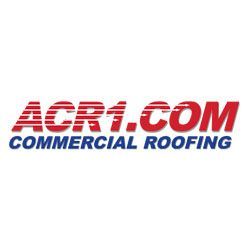
Author:
Floyd Mason
Born and raised in farming in Iowa
Worked in and around construction since 1977
BS in Corporate Finance and Financial & Estate Planning from Brigham Young University. Involved in Boy Scouts of America for more than 35 years, Scoutmaster 15 years Estimator, Project Manager, Sales Representative, Crew Leader, Laborer, Territory Manager, District Manager, Regional Manager, National Sales Manager,
ACR1.COM Sales & Marketing Manager since 2013.
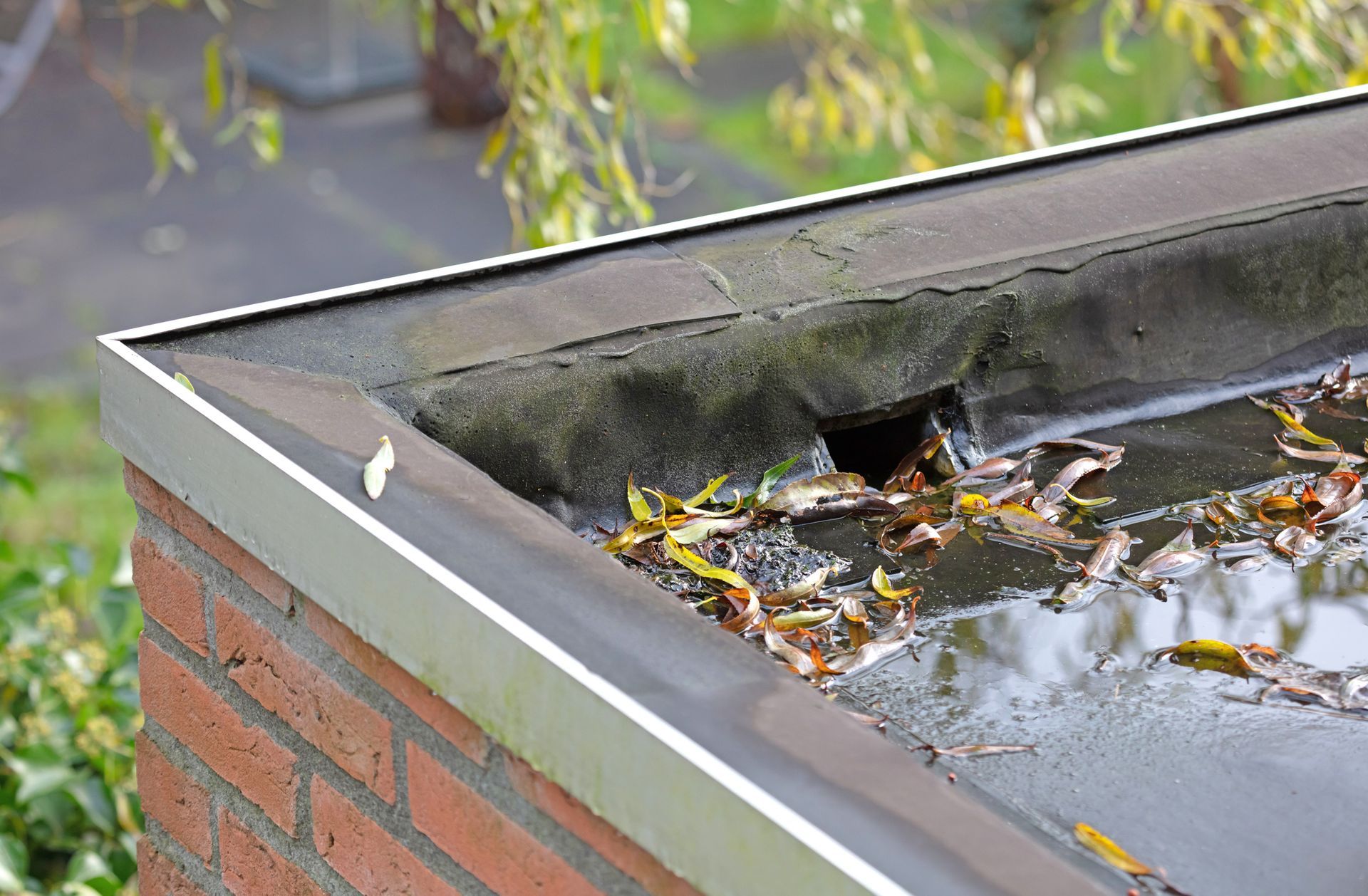
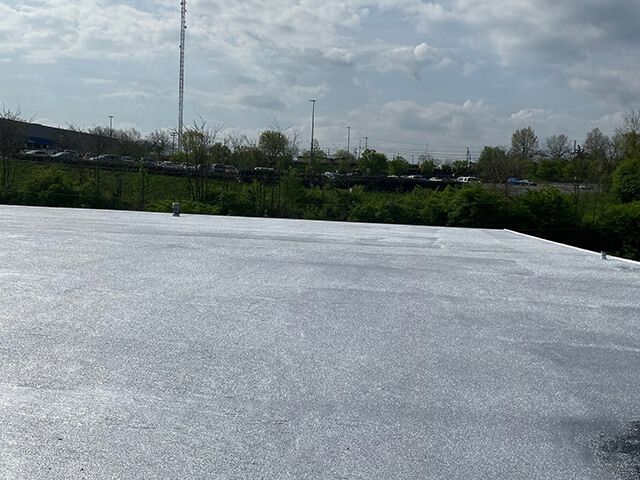
CONTACT US
Leaky roof? Want an estimate or roof inspection for your building? Contact us to schedule your service!
Contact Us
We will get back to you as soon as possible.
Please try again later.
Headquarters:
INDIANA OFFICE
1924 N ELM ST
MUNCIE, IN 47303
(317)820-2418
Quick Links


